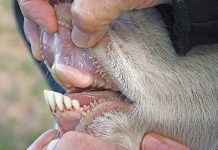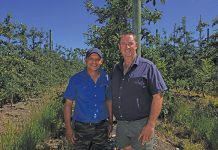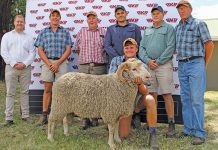
Photo: Andrew Jordaan Jr
The basis of the Andrew Jordaan en Seuns Merino stud is a flock of 3 500 highly productive ewes that have a mean weight of between 55kg and 60kg and produce an average of 1,5 lambs a year and 3,8kg of wool every eight months.
These admirable figures can be attributed largely to laparoscopic artificial insemination (LAI), a solid fodder flow programme and efficient management.
A family operation
The Merino stud is part of a larger family operation of cropping, dairy and beef in the greater Cradock area of the Eastern Cape. Andrew Jordaan Jr’s father and two older brothers manage separate divisions, with Jordaan himself responsible for the small-stock operations, which include 6 500 commercial Merino ewes and a Dormer stud of 250 ewes.
The foundation genetics of the Jordaan Merino stud were 100 stud ewes that Andrew Sr bought from his father’s stud, established in the early 1950s. In the 1980s, he launched an LAI programme, which, over the past four decades, has enabled the accelerated breeding of a productive Merino suited to conditions on the Jordaans’ properties.

“[LAI] has allowed for rapid genetic progression, and today we have sheep that perform very well in our area, where we combine pastures and veld,’’ says Jordaan.
“We use scientific data, such as BLUP breeding values, as well as visual appraisal to select functional, fertile and balanced sheep.’’
Another key advantage for the stud has been the development of an irrigated cropping initiative that today covers 1 000ha, thanks mainly to water rights linked to the Orange-Fish River Tunnel system.
The family’s cropping enterprise produces feed for all of the farming divisions and has allowed the small-stock initiative to benefit from a stable fodder flow programme. Apart from pastures, which are dominated by lucerne, ryegrass and chicory, and on which the ewes raise their lambs, roughage is processed into pellets at an on-site facility.
“Our fodder flow programme stabilises our livestock operations,’’ says Jordaan.
A critical management tool used in the stud has been the introduction of a radio-frequency identification (RFID) tag system, which collects data and enables Jordaan and his team to rapidly measure the relationship between genetics and production.
“The RFID tag system has made the handling of data so much easier, and we can now easily identify which animals produce well,’’ he says.
Extensive and intensive systems
Apart from the 10 to 12 weeks that Jordaan Merino ewes spend on pastures while raising lambs, they are always on the veld, supported by a standard lick regimen. Sweetveld
is designated for younger ewes, while older ewes are run on sourveld with a lick of a higher salt content.
Ewes are expected to handle rugged terrain with considerable tick loads (they are dipped with a portable facility) that traditionally would have been reserved for hamels [wethers].
“Our ewes are our hamels,’’ says Jordaan. “They produce wool like a hamel and give me lambs so, to me, it’s a far better option to farm ewes.’’
Diverse genetics
Jordaan Merinos have always been selected for multiple lambs, and rams are only selected from dam bloodlines with a history of twins and high production indices. All stud ewes (and 85% of the commercial flock) are inseminated laparoscopically. While 98% of the rams providing the semen for the LAI programme are self-bred, Jordaan still ensures that they are from as diverse a genetic background as possible.
“Genetic diversity in the flock serves as a form of hybrid vigour that has obvious advantages in terms of production,’’ he says.
Ewes are treated for internal parasites and flushed with a self-formulated production lick at six to four weeks before mating (and again before lambing).
Maiden ewes are mated for the first time between 11 and 12 months of age when they reach a weight of between 45kg and 48kg. They spend the first six months of life on pasture, and are then transferred to sweetveld and supplemented with a maintenance lick before mating. The stud has a ewe replacement rate of 25%.
Conception amongst the ewes is improved when they run on cooler, higher-altitude plateaus in the mountains.
However, all stud ewes will eventually lamb in pens in the autumn (April) and spring (August/September) lambing seasons. Stud ewes achieve an average lambing rate of 145% to 150% and a weaning rate of between 135% and 145%. While in the pens, lambs are tagged and entered into the RFID tag system, and also receive a vitamin supplement and preventative treatment against coccidiosis.
These lambs are released with their mothers onto pastures after 10 days in the pens to ensure adequate bonding between lambs and ewes.
Multiple-lamb ewes have the advantage
Ewes with single and multiple lambs are divided into separate flocks on the pastures. The flocks with multiple lambs are afforded better-quality grazing and receive creep feed a little earlier than the flocks with single lambs.
The lambs are given creep feed via self-designed feeders about two weeks after leaving the pens. Although openings in the feeders are designed to enable only the lambs to reach the feed, ewes can also gain limited access with some effort, which is behaviour that Jordaan encourages.
“The creep feed stimulates milk production, and also means the ewes lead the lambs to the feed on a regular basis,’’ he says.
When lambs begin struggling to reach the feed effectively (as their heads increase in size), Jordaan and his team dispense the feed into cages that the lambs can crawl into.
The ration is also changed to pellets to familiarise the lambs with the feed they will receive in the feedlots when weaned at about 10 weeks at an average weight of 26kg to 27kg.
Soon after weaning, the ewes are returned to the veld, while the lambs remain in the feedlots until they reach an average weight of 33kg at the age of between four and four-and-a-half months. They are then marketed to feedlots, and a portion are exported to the Middle East via the East London harbour.
Ideally, shearing takes place at eight months, but it can occur at 10 months. Eight- month wool (B to A length) has a better clean yield than 10-month wool (A to AA length). The average fibre diameter of the entire Jordaan wool clip has been 19,5 microns over the past few years, but decreased to 18,9 microns in the last season.
Just over half (55%) of the wool clip is sold under contract to the New Zealand Merino Wool Company at a predetermined price normally fixed 18 months in advance. This arrangement has proved invaluable for weathering price fluctuations brought about by unforeseen challenges such as the foot-and-mouth and COVID-19 outbreaks.
The family sells about1 500 Merino ewes every year, and markets 70 Merino rams (along with 30 Dormer rams) at their annual production sale. Rams are also marketed at the annual national Merino sale.
Email Andrew Jordaan Jr at [email protected].













